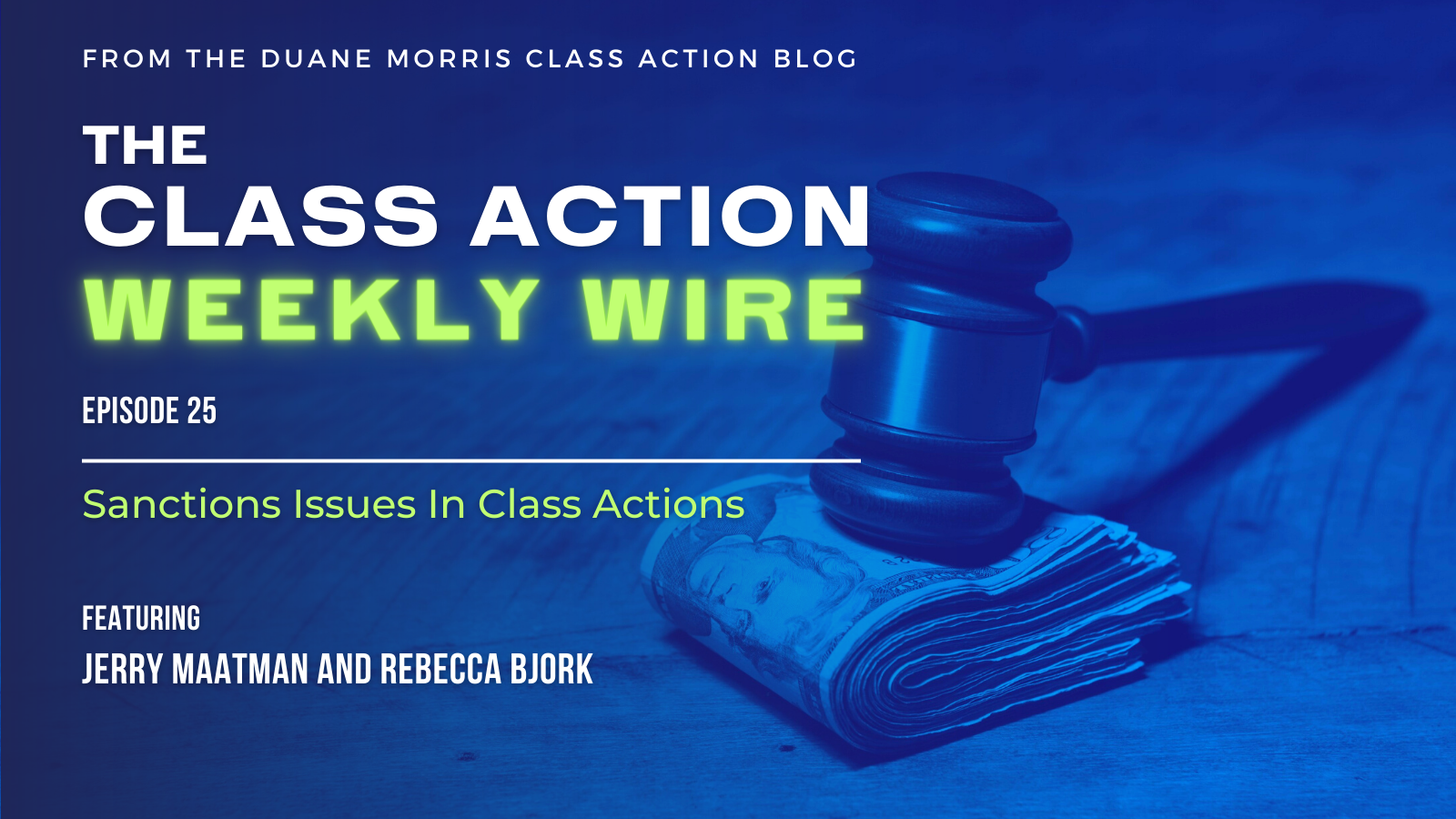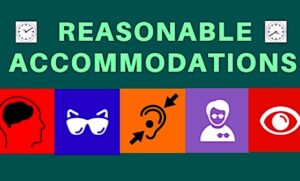Duane Morris Takeaway: This week’s episode of the Class Action Weekly Wire features Duane Morris partner Jerry Maatman and special counsel Rebecca Bjork with their discussion and analysis of key sanctions issued in class action litigation throughout 2022.
Jerry Maatman: Hello everyone and thank you for being here in our weekly installment each Friday of the Class Action Weekly Wire. Joining me today is Rebecca Bjork of our Washington D.C. office who is a special counsel in our Workplace Class Action Group.
Rebecca Bjork: Thanks – great to be here, Jerry.
Jerry: Today we have a little bit of a different topic – an important one and one that tends to rear itself from time to time in class action litigation, and that’s the topic of sanctions – either sanctions against the plaintiffs’ lawyer who brought the case or sanctions against defense counsel involved in the class action litigation. One of the chapters of our Duane Morris Class Action Review details the largest sanctions awards and rulings throughout the United States each year. Rebecca, what are some of the reasons that you’ve seen in the case law about why courts would ever enter sanctions in a class action?
Rebecca: Well, by way of background, sanctions really are simply thought of as penalties – in civil cases, they are typically in the form of a monetary fine, usually issued in response to violating some sort of court procedures or abusing the judicial process. And of course the most extreme sanction imposed in civil cases is dismissal with prejudice of the filing party’s claim – or on the other hand, dismissal of the answer of the responding party – so then the case would have no further movement going forward and it would be over with judgment against the party that was being sanctioned.
This actually happened in one case last year, Gui Zhen Zhu, et al. v. Matsu Corp., where the judge struck the defendants’ answer and entered a default judgment against them – and this was in a wage and hour collective action – and the reason for the sanction under Rule 37(b) was that their counsel disobeyed a court order to provide a class list for the provision of notice of the collective action under the Fair Labor Standards Act by the deadline that the court had set, and in addition the counsel had withdrawn his appearance without securing substitute counsel for the collective.
Jerry: It’s interesting – I’ve always thought that because sanctions are such an odious sort of end result of a lawsuit, that the losing party in the end of the sanctions are order often makes an appeal – and to me, one of the key decisions that I read in 2022 was the Tenth Circuit decision in the case of O’Rourke, et al. v. Dominion Voting Systems, Inc., which was a case where various citizens had sued saying that the presidential election was a fraud and that their votes weren’t counted. The defendants had to respond to the lawsuit, filed a motion to dismiss for lack of standing, judge granted it and found that in essence the lawsuit was frivolous, shouldn’t have been brought, that the arguments of the plaintiffs in terms of their standing were just entirely frivolous, and to the extent that even during oral argument they admitted as much and the district court judge entered sanctions of $187,000. The Tenth Circuit opinion affirming that decision in terms of the sanction order makes for very interesting reading – it’s almost a road map of what lawyers should not do, and a road map in terms of what lawsuits should not be brought because there’s no basis in law or fact for them to be brought – and you know kind of that notion of making a bad situation even worse where a district court sanction order is then broadcast nationwide in a court of appeals decision, which is exactly what happened, and it was picked up in the media and it’s become quite an important case. I think if you’re corporate counsel and you wanted to read one sanctions order – that Tenth Circuit decision would be kind of required reading in terms of the sanctions area.
Rebecca: That’s absolutely right, and if you’re a class action attorney you should probably be aware of the fact that sanctions can be awarded if settlement agreements are violated, and this happened last year in a case called Asset Acceptance, LLC, et al. v. Caszatt. The court granted a motion not only for sanctions but also for civil contempt and awarded the counterclaim defendant a payment of $387,314.04 in remedial damages to class members who were wrongly subject to collections. This was a debt collection class action, and the counterclaim plaintiffs’ counsel also had to pay the defendant’s attorneys’ fees, more than $1.1 million, and an additional monetary sanction of close to $1.2 million if they fail to pay within 30 days of the deadline set by the court.
Jerry: That’s a great point, Rebecca. In my experience another fertile ground where sanctions tend to be in the mix is with discovery and as we all know in class actions, discovery tends to be very laborious, very expensive – and if you’re a defendant it involves production of massive amounts of material, either written or electronically stored information. I read with interest the Hudgins, et al. v. Total Quality Logistics, LLC decision last year where there was a sanction order entered with respect to the manner and method by which the defendant had approached discovery, and the magistrate judge giving the defendant opportunity after opportunity and basically saying ‘I have no alternative but to sanction you and to impose monetary costs upon you because of the cavalier attitude and the positions you took in discovery.’ In my experience, magistrate judges lording over discovery – especially in federal court and especially in class actions – are getting very serious about that because of the potential costs and delays that are involved in games that are played with discovery.
Rebecca: That’s absolutely right, and not only monetary sanctions in the context of discovery are important to keep your eyes on, but also barring the use of evidence in the trial of the case. That happened in a case last year, L.D., et al. v. United Behavior Health, a class action alleging not paying sufficiently for out-of-network claims for substance use disorder and mental health treatments for people who were insured by the defendant. What happened in that case was that plaintiffs filed a motion for sanctions after the defendant submitted tens of thousands of documents in discovery after the discovery deadline had elapsed, and the court granted the plaintiffs’ motion and barred the defendant from using documents, audio records, an Excel spreadsheet – all of the information that they had failed to produce before the close of discovery.
Jerry: That’s a great example because sanctions or threats of sanctions are also used as a weapon, often by the plaintiffs’ bar against the defendants since discovery tends to be more focused on the defendants because they have the information, the data. In terms of the array of case law rulings in 2022, by your way of thinking, were there any notable rulings where judges backed up what defendants did and denied plaintiffs’ motions for sanctions in a class action?
Rebecca: Sure, absolutely there are instances where sanctions are denied even when a rule or proper procedure is violated if the defendant can show the court that there was no bad faith or willfulness on their part. This happened in a case in the state of Pennsylvania where it was involving people who were wards of the state who had profound intellectual disabilities, and they filed a class action alleging their civil rights were being violated. The name of the case is Jennings, et al. v. Wolf, and they failed to disclose an expert but released the expert’s report one day after the deadline. Plaintiffs still had four months left to rebut the testimony and they did, so the testimony didn’t come as a surprise to them, so the court found that there was no evidence of bad faith in order to apply any sanctions in that instance.
In a similar case, it wasn’t necessarily an issue of lack of bad faith that the defendant was able to convince the judge that they were not obligated under law to do what the plaintiffs’ side was asking them to do in a class action, and in this case it was producing the list of all putative class members’ names and addresses prior to certification. This was Holland-Hewitt, et al. v. Allstate Life Insurance Co., and again that court found that sanctions were not warranted in that situation.
Jerry: Well those are great insights and analysis Rebecca, I know you’re a subject matter expert in this area and I’m sure we’ll see more in 2023 since by their very nature, class actions involve very significant issues and lots of discoveries, so I’m sure corporate counsel will see other threats of sanctions and sanctions rulings down the line. Thank you loyal blog readers for joining us for our Friday weekly podcast – signing off, thanks so much.








